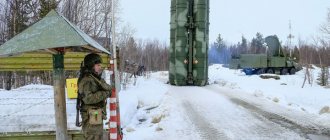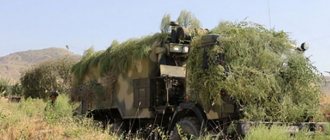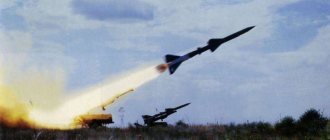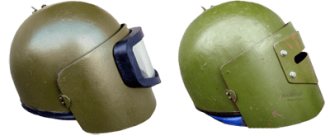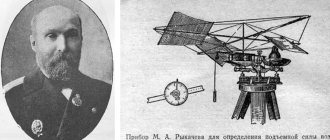Radio communications | USSR
Radio station RPO-1 (Partisan)
Radio station RPO-4
In 1941, Kharkov Plant No. 193 developed a portable radio station for partisan detachments (RPO) based on the experimental Omega. It was produced by several factories in the following versions: “RPO-1”, “RPO-2”, “RPO-3” and “RPO-4”. The first option was unofficially called “Partisan”. The station was built on 2 lamps, in general, a metal case for the receiver and transmitter. A total of 560 radios were released. TTX radio station: power – 30 W; communication range – 300 km.
Portable radio station "North"
Serial production of the radio station “Sever” (Severok) began in October 1941. It was intended to equip reconnaissance units and partisan detachments. The radio station is simplex, telegraph, portable, battery powered. Direct amplification receiver, three-stage, with regenerative feedback. It is made on three small-sized lamps with independent settings of the receiver and transmitter. The radio station was equipped with a 12 m long inclined beam antenna with a collapsible counterweight and guys, headphones, a small telegraph key, a spare set of lamps, tools and materials for repairs. The entire set, along with power supplies, was placed in two canvas bags. There was an AC powered option. A total of 19.6 thousand stations were released, of which 7 thousand were sent behind the front line alone. There were naval versions of radio stations for naval reconnaissance under the designations: “Mullet”, “Flounder”, “Volley”, “Zaryad”. Performance characteristics of the radio station: frequency range (reception/transmission) - 3.6-12.2/3.6-6.2 MHz; transmitter output power - 2 W; range - up to 400 km; power supply - 4 BAS-60 batteries and 2 3C cells; dimensions 180×150×100 mm; weight - 2 kg; battery weight - 6 kg; weight of the complete set - 10 kg.
Radio station Sever-bis
The radio station differed from the basic one by operating at fixed frequencies using replaceable quartz and was produced since 1942. Performance characteristics of the radio station: Frequency range - 2.2 - 6.6 MHz; types of work - TLG; power – 2.5 W; communication range – 400 km; antenna – beam – 12 m; power supply – batteries; weight – 2 kg; weight of power supplies – 6 kg; dimensions – 180x150x100 mm.
Nabla radio set
The radio station was developed in the laboratories of the NKVD and consisted of three blocks: a transmitter, a receiver and a power supply. It was intended for special forces agents to transmit information over long distances. The two-stage transmitter was assembled using three 6L6 tubes (VT-115). Performance characteristics of the radio station: frequency range – 18.5-35 m and 35-70 m; power – 40 W; communication range – 2000 km; power supply – from AC mains.
Tensor radio set
The portable radio station was built on 5 lamps and consisted of three blocks. It was used in military intelligence to transmit information over long distances. TTX radio station: frequency range – 3.7-14.3 MHz; power – 45 W; power supply – from AC mains; communication range 2,500 km; weight – 7 kg.
Agent radio station Jack
To transmit intelligence data over long distances, the Jack radio station was used, which was produced since 1941. It consisted of a transmitter, receiver and antenna with accessories. The radio station was placed in a suitcase measuring 160x400x650 mm. Transmitter performance characteristics: frequency range – 3.7 – 16.7 MHz; types of modulation – AM, R/T and CW; power – 50 W; power supply – from AC mains; communication range – 2,500 km; weight – 25 kg; antenna - wire 15 m long.
Portable radio station Prima
The radio station was produced by Kharkov Radio Plant No. 193 since 1941 and was intended for telegraph communication of partisan detachments and units of airborne troops. Since 1942, a second version was produced, which was smaller in size. The radio station was built on 4 lamps. Performance characteristics of the radio station: frequency range – 3.3 – 5 MHz; sensitivity – 15 µV; power – 8 W; antenna – inclined beam 25 m long; communication range – 300 km; power supply – from a manual generator or from a battery; dimensions – 420x380x160 mm or 385x400x160 mm; weight – 14.9 or 15.5 kg.
Radio station Belka-4-TUD
The radio station was produced at factory No. 696 since 1944 and was intended for intelligence agencies. It consisted of a receiver (assembled on 3 lamps), a transmitter (assembled on 2 lamps) and antenna accessories with a telegraph key. The Belka-4TUD variant is known for airborne units in a metal container. During the war, 3.5 thousand stations were produced. TTX radio station: power – 5 W; communication range – 1000 km; power supply – from AC mains.
Receiver and transmitter of the Belka-5 radio station
Radio station RKR
Portable radio station 6-PK
The radio station was a variant of the “6-PK” station, intended for communications in the cavalry. In accordance with the purpose of the station, the overall dimensions of the packages, as well as the antenna device, have been changed and made more convenient for attaching them to the saddle.
The radio range, power supplies and receiver circuits are left unchanged. The total weight of the radio station with the packing device is about 47 kg. The station was transported on horseback, the pack device was attached to the cavalry saddle. The radio station could operate without changing the power source for 6 hours of transmission and 18 hours of reception. A 4.8 m high pin (from the saddle) was used as an antenna, and a 15 m long wire was used as a counterweight. Station range: with an equivalent telegraph - 25 - 30 km; with radio station 5-AK-1 - telephone 20 km, telegraph 40 km.
The radio station was put into service in 1931, and in 1938. underwent modernization. It was intended for communication between the battalion commander and the regiment commander and for working in the networks of artillery divisions. The station is also known as “Malaya Politotdelskaya”. It was used in the initial times of the war, and then was used for training purposes. It could work by telephone and telegraph, while stationary and on the move, and was serviced by two radio operators. The radio station consisted of two packages - a transceiver and a power supply. TTX station: frequency range - 3.7 - 5.2 MHz; operating modes - TLF and TLG, output power - 1 W; communication range with a whip antenna is 10 km, with a beam antenna – 15 km; power supply - from a 4NKN-10 type battery and two BAS-80 dry batteries; radio station weight – 13 kg; power supply weight – 12 kg.
Radio station RP-L
The telephone and telegraph radio station was intended to provide radio communications at the regiment-division level. It was manufactured in 1942 in besieged Leningrad from parts of broadcast radio receivers. The radio station consisted of two packages - a transceiver package and a power package. A total of 400 stations were released. Performance characteristics of the radio station: frequency range - 3-5 MHz; communication range - 15 km; power supply: 2NKN-10 battery and two BAS-80 batteries; weight - 34 kg.
Portable radio station 5-AK
The telephone-telegraph, receive-transmit, simplex radio station “5-AK” was put into service in 1929 and was intended to work in divisional networks of infantry and cavalry, as well as in regimental artillery networks. It consisted of a “20-KV-1” transmitter and a “5-RKU” receiver, power sources, an antenna device, and a set of spare and auxiliary equipment. The station could operate while moving or stationary and was serviced by a team of 3-5 people. The radio station was mounted in a car with a body, a cart, a gig, on packs or in boxes. Since 1939, a modification of the radio station with an extended transmitter range (3 - 4.875 MHz) was produced under the designation “5-AK-1M”. TTX radio station: frequency range - 3.25 - 4.75 MHz; power – 5 – 10 W; types of modulation - TLF and TLG; communication range - 50 km; set weight – 130 kg.
Portable radio station A-7
Portable radio station A-7A
Portable radio station A-7B
A radio station with a mechanical half-duplex “A-7” with 11 lamps was produced since the end of 1942 for rifle regiments and artillery divisions. Since 1943, a modernized version of the “A-7-A” with 9 lamps, as well as a naval version of the “Raid-I”, were produced. Since December 1944, production of “A-7-B” was launched using 10 lamps with increased transmitter power and receiver sensitivity.
Portable radio station A-7B
The radio station could be used as a telephone in a wired communication network and controlled remotely. It was placed in one wooden package with straps for carrying behind the back. The kit was carried over long distances by two soldiers. The radio station was operated by one radio operator. Deployment time - no more than 5 minutes. In total, at least 30 thousand stations were released. TTX station: frequency range – 27 – 32 MHz; transmitter output power – 1/2/2.5 W; receiver sensitivity – 1 – 1.5 µV; antennas - whip 2.5 m long and beam antenna 6.4 m long; communication range - 10 km; power supply – two BAS-80 batteries and two 2NKN-10 batteries; operating time from one set – 35 – 40 hours; dimensions - 285x135x165 mm; weight of the complete set - 23 kg.
Radio station Reid-I
The radio station was a ship version of the “A-7” and was intended for naval artillery fire spotters. It had the same tactical data as the A-7, with the exception of greater power when operating in telegraph mode.
Portable radio station 13-R
A combined-arms simplified radio station was created in 1942 on the basis of pre-war parts and components for serial broadcast radio receivers. Often, receivers confiscated from the population after the start of the war were dismantled for parts. The station was used in infantry and artillery regiments. The receiving part is a 6-tube superheterodyne with one frequency conversion. The transmitter is assembled on one lamp (self-oscillator). The radio set included: a transceiver, power supplies, antenna equipment and other accessories, which were placed in a plywood box with straps for carrying on the back.
A version of the radio station was produced under the designation “13-RA”, which differed in the range (3.5 - 5.5 MHz), the absence of a telegraph operating mode, lower transmitter output power and the size of the whip antenna (1.9 m). TTX radio station: frequency range - 1.75 -4.25 MHz; output power - 0.5 W; range - by telephone (telegraph) on a whip antenna 2.65 m high - 12 (17) km, on a beam antenna 11 m long with a suspension height of 3-4 m and with a counterweight 11 m long - 18 (25) km; power supply: four BAS-60 dry batteries and 2-NKN-10 batteries; operating time from one power supply – 25 – 27 hours; dimensions - 490×370×270 mm; set weight - 20 kg.
Portable radio station RB (3-R)
The battalion radio station (RB) was intended for communication in infantry and artillery regimental networks. It was produced in 1938-1943. Until 1940, the station body was made of aluminum, after which it was made of steel. The batteries were placed in a separate box. A cavalry version of the radio station is known under the designation “RBK” (3-RK) with a total pack weight of 52 kg. It was equipped with a manually driven generator “DRL-1-B”. TTX station: frequency range - 1.5 - 6 MHz; operating modes - TLG and TLF; transmitter output power - 0.5 W; power supply – four BAS-60 batteries and a 2-NKN-22 battery; dimensions - 340x240x190 mm; station weight - 10.4 kg; power supply weight – 14.5 kg; weight of the antenna array of the dipole – 3.5 kg; antenna – whip, 1.8 m long.
Radio station RB-M-5 model 1943 (five-watt)
Radio station RB-M arr. 1942 (one watt)
The modernized battalion radio station (RB-M) was a development of the “RB” model and was put into production in 1942 in two modifications: RB-M (output power 1 W) and RB-M-5 (in production since 1943, output power 5 W). The radio station was simplex, telephone and telegraph, portable, self-powered and intended for communication in regimental and divisional radio networks of infantry and artillery. Separate receiver and transmitter are assembled on a common chassis. Batteries and accumulators were placed in a separate battery box. The radio station allowed communication from a point remote from the transceiver at a distance of up to 2 km, and could also be used in wired communication networks as a telephone. The complete set of the radio station (with antenna mast and dynamo) was carried by three people. In total, at least 20 thousand RB-M stations and about a thousand RB-M-5 stations were manufactured. TTX station: frequency range - 1.5 - 5 MHz; operating modes - TLG and TLF; output power – 1/5 W; receiver sensitivity in telephone mode - 10 µV; range up to 50 km; power supply - four BAS-60 batteries or three BAS-80 batteries and a 2-NKN-22 battery; Operating time from one set of batteries is up to 36 hours; dimensions - 345x195x260 mm; station weight - 11.5 kg; power supply weight – 16 kg; antenna packing weight – 3 kg; antennas - whip, 1.8 m long, horizontal dipole-type antenna, collapsible vertical antenna mast 7 m high with a counterweight.
Portable radio station RRU
The station was put into service in 1938 and was intended for communication in the radio network of a rifle battalion on 58 fixed frequencies. TTX station: frequency range 33.2 – 40.5 MHz; operating modes - TLF and TLG; communication range – 4 km; output power – 0.1 W; power supply – 4-AKN-2.25 battery and two BAS-60 batteries; antenna – whip, 1.6 m long; counterweight – wire 1.4 long; dimensions - 235x115x300 mm; weight – 8 kg; calculation – 1 person.
Portable radio station RRS
The radio station was put into service in 1940 and was intended for communication in the radio network of a rifle battalion. The station was serviced by one radio operator and could work on the spot and on the move. TTX radio station: frequency range - 33.5 - 37.25 MHz; communication range – 3.5 km; antenna - whip.
Portable radio station RBS (4-R)
The radio station was the result of the modernization of the RRU station, was put into service in 1940 and was produced by factories No. 512 and 564. It was intended for organizing communications within the battalion and operated on 58 fixed frequencies. The station was assembled with 4 lamps and could work as a phonic telephone set. It was carried in two packages, combined into one for carrying on a shoulder strap. TTX radio station: frequency range - 33.25 - 40.5 MHz; types of modulation - TLF and TLG; power – 0.25 W; antenna – whip 1.37 m long with counterweight; communication range - 5 km; dimensions – 242x124x338 mm; weight – 12 kg.
Radio station RBS-A (4-RA)
The radio station was an artillery version of the RBS and differed from it in the presence of a package with additional power with two series-connected BAS-60 batteries, which were connected to the main power package of the radio station. The power supply ensured continuous operation of the radio station for 20 hours. Set weight – 16 kg; communication range – 6 km.
Portable radio station 12-RP
The radio station has been produced since 1941 for communication in the networks of rifle and artillery units. In 1942, on the basis of “12-RP”, tank radio stations “12-RT” and “12-RPB” were produced, which were installed on light tanks, self-propelled guns and armored vehicles. The radio station was carried behind the back on belts by two soldiers. The radio station consisted of separate transmitter and receiver units. A total of 26.4 thousand stations were released. TTX station: frequency range – 2-6 MHz; operating modes - TLG and TLF; output power - 0.5 W; powered by four BAS-60 batteries and a 2NKN-22 battery; station dimensions - 426x145x205 mm, weight - 12 kg; Dimensions of the power supply - 310x245x185 mm; power supply weight – 13.1 kg; antennas - a whip 1.5 m or 2.2 m long and an L-shaped antenna with an inclined counterweight, consisting of two beams 14 m and 9 m long.
Radio station RL-6
The radio station was produced at plant No. 619 in 1941-1943. and was intended for communication in telephone and telegraph modes in the networks of a rifle or artillery regiment. The station was assembled on the basis of radio components from broadcast receivers of the 6N-1 type. In 1942, the station was modernized, one lamp was added, and was produced under the designation “RL-7”. It consisted of two packages - a transceiver package and a power package. TTX radio station: frequency range - 3.3 - 5.45 MHz; communication range – 3/15 km; antenna – whip, 2 m long or horizontal dipole 20 m long; dimensions – 365x285x295 mm; food packaging dimensions – 365x310x270 mm; weight - 13 kg; food package weight – 18 kg.
RSB-F mobile radio set
RSB-F transmitter
The radio station was produced since 1940. “RSB-F” consisted of an “RSB-F” transmitter and “US” or “KS-2” receivers. The radio station could be mounted in GAZ-AAA, GAZ-AA, Willys cars, in carts, snowmobiles or in transportable boxes. In the latest version, the property of the RSB-F radio station was placed in 6 wooden boxes with a total weight of 480 kg. Performance characteristics of the radio station: frequency range - 2.5 -12 MHz; types of work - TLG and TLF; output power - 50 W; communication range – 100/1500 km; antenna - 4-meter rod or vertical beam 10 m long; power supply – 26V DC; transmitter dimensions - 349x305x203 mm; weight - 14 kg.
Transmitter RSI-3M
Transmitter RSI-3M1
Receiver RSI-4A
Receiver RSI-4
A series of aviation radio stations "RSI" (fighter radio station) was produced in three modifications: "RSI-3", "RSI-4" and "RSI-6". The RSI-3 set was put into service in 1939. It consisted of an RSI-3 Sokol receiver, an RSI-3 Orel transmitter, a power supply, a radio mast, a telephone and a GS-10-350 electric generator. In 1940, modifications “RSI-3M” and “RSI-3M1” appeared, which had no external differences from the base station. The station was used on MiG-1 and MiG-3 aircraft. Power supply: two BAS-MGK(60) batteries and a 2-NKN-10 battery; frequency range – five fixed frequencies. Since 1942, “RSI-4” was installed on aircraft: “MiG-3”, “LaGG-3”, “La-5”, “I-16”, “I-15”, “Yak-1”, “ Yak-3", "Yak-7", "Yak-9", "IL-2" and "Pe-3". The station consisted of an RSI-3M1 transmitter, an RSI-4A receiver, RUN-45A and RU-11A umformers and a T-shaped antenna (horizontal length - 2.6 m, descent length - 1. 2 m). A tank version of the receiver is known under the designation “RSI-4T”. In total, at least 120 thousand stations of all types were produced. Performance characteristics of the RSI-3M transmitter: frequency range - 3.7-5 MHz; output power - 3.5 W; communication range – 150 km; operating modes – TLF; power supply - from the aircraft's on-board network via the RU-45A umformer: dimensions - 150x120x190 mm. Performance characteristics of the RSI-4A receiver: frequency range - 3.7-6 MHz; operating modes – TLF; power supply - from the aircraft's on-board network through the RU-11A umformer; dimensions - 15x120x155 mm; weight – 12.3 kg.
Transmitter RSI-6K
Aviation receiver RSI-6M1
The RSI-6 station was produced by plant No. 590 as a development of the RSI-4 and was put into service in 1943. The station kit included: the RSI-6 transmitter, the RSI-6MU receiver; umformer "RU-45A" and "RU-11A"; remote control unit and beam antenna. The “RSI-6MU” modification using umformers is known. The station was used on aircraft: “Li-2”, “La-7”, “Yak-3” and “Il-10”. In total, at least 11 thousand stations of all types were produced. Performance characteristics of the RSI-6M1 receiver: frequency range - 3.7 - 5 MHz; operating modes - TLF; power supply - from the on-board network 26V; dimensions - 290x140x225 mm; weight - 5.8 kg. Performance characteristics of the RSI-6K transmitter: frequency range - 3.7 - 5 MHz; operating modes - TLF; output power - up to 8 W; communication range - up to 120 km; power supply - from the 26V on-board network through the RU-45A umformer; dimensions - 223x175x290 mm; weight - 3.5 kg.
Receiver 71-TK-1 complete with shock absorber
Tank radio transmitter 71-TK-1
The receiving-transmitting, telephone-telegraph radio station “71-TK-1” (Jackal) was produced at plant No. 203 since 1933 on the basis of the prototype “71-TK”. It was intended for communication between commanders of tank units, from platoon to battalion, and was installed in the vehicles of these commanders. The receiver and transmitter were made as separate devices and were installed on special frames with shock absorbers to protect them from shaking. The station allowed joint operation with tank intercoms. The radio station was installed on command tanks "T-26", "T-28", "T-37", "BT-5", "BT-7", armored vehicles "BA-3" and "BA-20", as well as for T-35, KV tanks and armored trains. On tanks and armored vehicles, a combination of a whip and handrail antenna was used, which was a half-ring of a metal pipe mounted around the turret on insulating brackets. The transmitter allowed continuous operation for 30 minutes, after which a break of 20 - 30 minutes was required to cool down. In 1935, a model of the station with an increased range was produced under the designation “71-TK-2”, which was also used on the KV-1 and IS-1 tanks. Performance characteristics of the radio station: frequency range – 4-5.6 MHz; types of work – TLG and TLF; power – 3 – 5 W; telephone communication range - 10 - 30 km while driving, 40 km when parked with the engine not running; power supply – 12V from the on-board network; transmitter dimensions without shock-absorbing frame – 320x216x210 mm; dimensions of the receiver without shock-absorbing frame – 388x207x201 mm; weight of the kit without antenna – 80 kg.
Receiver of tank radio station 71-TK-3
Tank radio transmitter 71-TK-3
Radio station “71-TK-3” arr. 1939 was the result of the modernization of the "71-TK-32" and was installed on the tanks "BT-5", "BT-7", "T-40", "T-60", "T-34" of early releases, " KV-1", "KV-2", armored vehicles "BA-11". It featured an improved element base. The radio station was intended to provide two-way communication between armored vehicles and other branches of the military. The radio set included a telegraph key, a microphone, and headphones. By June 1941, more than 3 thousand stations of all types were produced. Performance characteristics of the radio station: sensitivity - 15 µV; frequency range – 405.6 MHz; types of work – TLG and TLF; output power - 5 - 8 W; communication range – 40 km; power supply of the transmitter is from a battery through an umformer, the receiver is powered from two batteries with a voltage of 80 V each and an alkaline battery; operating time from one set of batteries is 15 - 20 hours; antenna - a combination of a whip and handrail antenna; transmitter dimensions without shock-absorbing frame - 320x216x210 mm; weight – 60 kg.
Share to:
Pages: 1
Production of domestic military communications equipment in 1940-1945. Part 1
The head of the Communications Directorate of the USSR Armed Forces, Major General Nikolai Ivanovich Gapich, seven months before the start of the war, prepared a report “On the state of the Red Army communications service,” which went to the desk of the People’s Commissar of Defense Semyon Konstantinovich Timoshenko. It said, in particular: “Despite the annual increase in the number of communications equipment supplied to the troops, the percentage of provision of communications equipment not only does not increase, but, on the contrary, decreases due to the fact that the increase in the supply of products is not proportional to the growth in the size of the army. The large shortage of communications equipment for the deployment of new military units does not allow the creation of the necessary mobilization reserves for the first period of the war. There are no carryover reserves either in the center or in the districts. All property coming from industry is immediately, “off the shelf”, sent to the troops. If industry supplies of communications equipment remain at the same level and there is no loss in communications assets, then to meet the full needs of NPOs without creating mobilization reserves, it will take more than 5 years for a number of items.”
It is worth noting separately that Nikolai Ivanovich was removed from his post as head of the Red Army Communications Department on June 22, 1941, and on August 6 he was arrested. It was a miracle that he was not shot, he was sentenced to 10 years and was rehabilitated in 1953.
Head of the Red Army Communications Directorate, Major General Nikolai Ivanovich Gapich
It was the rapid growth of the USSR army (from the autumn of 1939 to June 1941 it increased 2.8 times) that became the reason for the acute shortage of communications equipment in combat units. In addition, the People's Commissariat for the Electrical Industry (NKEP) was not part of the defense commissariats, and therefore was not included in the list of those supplied in the first place. Factories supplying the army with communications equipment were built in tsarist times - among them are Erickson, Siemens-Halke and Geisler. The work to modernize them was purely cosmetic and did not at all meet the needs of the huge Red Army.
Leningradsky (former Tsarist "Erikson")
The most important suppliers of army communications equipment in the pre-war period were a group of factories from Leningrad: No. 208 (RAT radio stations); “Red Dawn” (telephones and long-distance communication devices); telegraph plant No. 209 (Bodo and ST-35 devices); No. 211 (radio tubes) and (field telephone and telegraph cable). There was also a production “cluster” in Moscow: plant No. 203 (portable station RB and tank 71TK), Lyubertsy No. 512 (battalion RBS), and the Kolchuginsky and Shchelkovo radio tube plants also worked for the needs of the army. In Gorky, at the country's oldest plant No. 197, radio stations 5AK and 11AK, automobile and stationary RAF and RSB, as well as tank radio communication stations were manufactured. Kharkov plant No. 193 was engaged in radio receivers and various radio reconnaissance equipment. Morse and ST-35 telegraph devices were assembled at the Kaluga Electromechanical Plant No. 1, and anode batteries and accumulators were made in Saratov, Irkutsk and Cheremkhovo. In fact, in the decade preceding the war, only four enterprises were put into operation in the USSR, partially or fully engaged in the production of radio equipment for the army. These were small radio factories No. 2 (Moscow) and No. 3 (Alexandrov), engaged in the production of broadcast radio receivers, as well as an electromechanical plant in the Losinoostrovsky district of Moscow.
To be fair, it is worth noting that Major General Gapich in his report not only states the deplorable situation of the radio industry, but also proposes a number of urgent measures:
Speed up the construction and commissioning of factories: telephone equipment in the city of Molotov - Ural; tank radio stations in Ryazan (Resolution KO3 under the Council of People's Commissars of the USSR dated 7.V.39 No. 104 with a readiness date of 1st quarter 1941); special air defense radio installations in Ryazan (Resolution of the KO under the Council of People's Commissars of the USSR dated 2.IV.1939 No. 79); standard radio components in Ryazan (Resolution of the KO under the Council of People's Commissars of the USSR No. 104 dated 7.V.39 with a readiness date of 1.1.1941); - oblige: NKEP in 1941 to produce telephone equipment in Krasnodar (measuring instrument plant); NKChermet USSR to increase in 1941 at least twice the production of tinned steel wire for the production of field cables and master the production of thin steel wire with a diameter of 0.15 - 0.2 mm; NKEP USSR to organize workshops for manual dynamo drives at plant No. 266 in order to increase the production of these machines in 1941 to 10,000 - 15,000 units; - allow the immediate use for the production of field telephone equipment of the plant in Tartu (Estonia), which until now produced telephone equipment for the Baltic armies; and the VEF plant (Riga), which has very valuable equipment and qualified personnel; - for the needs of operational communications, oblige the NKEP of the USSR to master and supply to the NPO as a pilot batch in 1941 500 km of 4-core pupinized cable with devices for unwinding and winding the cable according to the model purchased in Germany and used in the German army; - transfer the following enterprises to NKEP USSR for the production of field radio stations: Minsk Radio Plant NKMP4 BSSR, NKMP RSFSR; Odessa Radio Plant NKMP of the Ukrainian SSR; Krasnogvardeysk Gramophone Factory - VSPK; buildings of the Rosinstrument plant (Pavlovsky Posad) of the NKMP RSFSR with the equipment of their NKEP by the 2nd quarter of 1941; the building of the former Vilna Radio Factory in Vilnius, using it for the production of radio equipment from the 3rd quarter of 1941; – free the city of Voronezh and No. 3 of the city of Alexandrov from the production of some consumer goods, loading the factories with military orders.
Gorky plant No. 197 named after. IN AND. Lenin
Naturally, it was not possible to fully implement the entire proposed program several months before the war, but the real disaster happened with the beginning of the war. In the very first months, a considerable part of the military communications fleet was irretrievably lost, and the mobilization readiness of enterprises, as they were then called, “low-voltage industry” was insufficient. The unfortunate geostrategic position of radio industry enterprises before the war had an extremely negative impact - the bulk of the factories had to be hastily evacuated. During the first period of hostilities, Gorky Plant No. 197 was the only one in the country that continued to produce front-line and army radio stations, but its capacity, naturally, was not enough. The plant could produce only 2-3 copies of the RAF per month, 26 of the RSB-1, 8 of the 11AK-7 and 41 of the 5AK. The production of telegraph devices such as Baudot and ST-35 had to be temporarily stopped. What kind of satisfaction of the needs of the front could we be talking about here?
At the beginning of the war, RAF was produced only at Gorky Plant No. 197
How did the military communications industry cope with its tasks during the war?
The relocation of the Leningrad group of factories began already in July–August, the Moscow group in October–November 1941. Of the 19 enterprises, 14 (75%) were evacuated. At the same time, factories that produced the bulk of radio equipment and components for them (RAT, RB, RSB radio stations, radio tubes and power supplies) were evacuated.
RAT is one of the most “scarce” radio stations of the Great Patriotic War
The problem with RAT radio stations was especially acute. In 1941 and 1942, the front headquarters had only one radio station, which did not guarantee the maintenance of uninterrupted radio communications with Headquarters. The role of these radio stations in ensuring communications between Headquarters and the fronts and armies increased with the beginning of equipping troops with special “high-speed” equipment (i.e., Almaz-type radio-printing equipment).
The evacuation of most factories was not planned in advance and was therefore carried out in an unorganized manner. In the new locations, the evacuated factories had neither adequate production space nor the minimum required amount of electricity.
Many factories were located in several premises in different parts of the city (in Petropavlovsk - in 43, in Kasli - in 19, etc.). This, of course, affected the pace of restoration of production in new places and, consequently, the satisfaction of the army’s needs for radio equipment. The government was forced several times to consider the issue of the timing of the launch of evacuated radio factories. However, despite the measures taken, none of the government-established deadlines for the restoration and launch of radio factories in new locations could be met.
The country's radio industry was only “reanimated” by the beginning of 1943, and after that (with the support of a Moscow group of factories) there was already a tendency toward a steady increase in the supply of radio communications equipment to the troops.
The ending follows...
Based on materials: Belov F.I. Stages of radio armament of the communications troops of the Soviet Army. - M.: Military Scientific Society at the CDSA named after M.V. Frunze, 1999. Rostokin I.M. Development of wire communications technology in the Soviet Army over fifty years. - M.: Military Scientific Society at the CDSA named after. M.V. Frunze, 1969. Gapich N.I. Some thoughts on issues of control and communications // Military Historical Journal. 1965. No. 7. Peresypkin I.T. Communication in the initial period of the war. - M.: Military Publishing House, 1960. Communications in the Great Patriotic War of the Soviet Union 1941–1945. (Bet-front). - L.: VAS, 1961. Zharsky A.P., Medvetsky A.G. Improving communications during the Great Patriotic War. Information collection on communications and automation.

